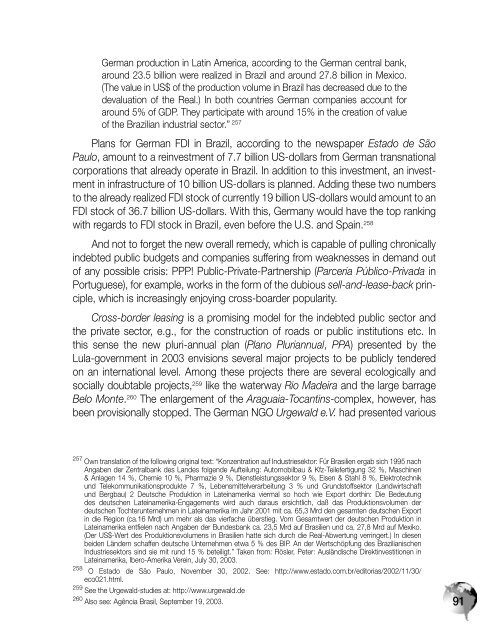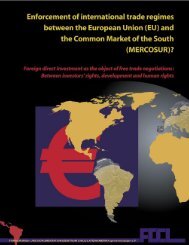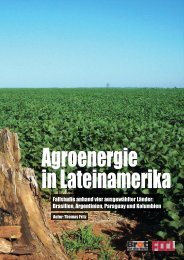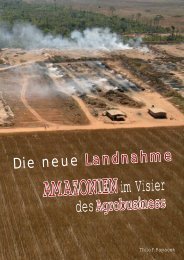(EU) and the Common Market of the South (MERCOSUR)? - FDCL
(EU) and the Common Market of the South (MERCOSUR)? - FDCL
(EU) and the Common Market of the South (MERCOSUR)? - FDCL
You also want an ePaper? Increase the reach of your titles
YUMPU automatically turns print PDFs into web optimized ePapers that Google loves.
German production in Latin America, according to <strong>the</strong> German central bank,<br />
around 23.5 billion were realized in Brazil <strong>and</strong> around 27.8 billion in Mexico.<br />
(The value in US$ <strong>of</strong> <strong>the</strong> production volume in Brazil has decreased due to <strong>the</strong><br />
devaluation <strong>of</strong> <strong>the</strong> Real.) In both countries German companies account for<br />
around 5% <strong>of</strong> GDP. They participate with around 15% in <strong>the</strong> creation <strong>of</strong> value<br />
<strong>of</strong> <strong>the</strong> Brazilian industrial sector.” 257<br />
Plans for German FDI in Brazil, according to <strong>the</strong> newspaper Estado de São<br />
Paulo, amount to a reinvestment <strong>of</strong> 7.7 billion US-dollars from German transnational<br />
corporations that already operate in Brazil. In addition to this investment, an investment<br />
in infrastructure <strong>of</strong> 10 billion US-dollars is planned. Adding <strong>the</strong>se two numbers<br />
to <strong>the</strong> already realized FDI stock <strong>of</strong> currently 19 billion US-dollars would amount to an<br />
FDI stock <strong>of</strong> 36.7 billion US-dollars. With this, Germany would have <strong>the</strong> top ranking<br />
with regards to FDI stock in Brazil, even before <strong>the</strong> U.S. <strong>and</strong> Spain. 258<br />
And not to forget <strong>the</strong> new overall remedy, which is capable <strong>of</strong> pulling chronically<br />
indebted public budgets <strong>and</strong> companies suffering from weaknesses in dem<strong>and</strong> out<br />
<strong>of</strong> any possible crisis: PPP! Public-Private-Partnership (Parceria Público-Privada in<br />
Portuguese), for example, works in <strong>the</strong> form <strong>of</strong> <strong>the</strong> dubious sell-<strong>and</strong>-lease-back principle,<br />
which is increasingly enjoying cross-boarder popularity.<br />
Cross-border leasing is a promising model for <strong>the</strong> indebted public sector <strong>and</strong><br />
<strong>the</strong> private sector, e.g., for <strong>the</strong> construction <strong>of</strong> roads or public institutions etc. In<br />
this sense <strong>the</strong> new pluri-annual plan (Plano Pluriannual, PPA) presented by <strong>the</strong><br />
Lula-government in 2003 envisions several major projects to be publicly tendered<br />
on an international level. Among <strong>the</strong>se projects <strong>the</strong>re are several ecologically <strong>and</strong><br />
socially doubtable projects, 259 like <strong>the</strong> waterway Rio Madeira <strong>and</strong> <strong>the</strong> large barrage<br />
Belo Monte. 260 The enlargement <strong>of</strong> <strong>the</strong> Araguaia-Tocantins-complex, however, has<br />
been provisionally stopped. The German NGO Urgewald e.V. had presented various<br />
257<br />
Own translation <strong>of</strong> <strong>the</strong> following original text: “Konzentration auf Industriesektor: Für Brasilien ergab sich 1995 nach<br />
Angaben der Zentralbank des L<strong>and</strong>es folgende Aufteilung: Automobilbau & Kfz-Teilefertigung 32 %, Maschinen<br />
& Anlagen 14 %, Chemie 10 %, Pharmazie 9 %, Dienstleistungssektor 9 %, Eisen & Stahl 8 %, Elektrotechnik<br />
und Telekommunikationsprodukte 7 %, Lebensmittelverarbeitung 3 % und Grundst<strong>of</strong>fsektor (L<strong>and</strong>wirtschaft<br />
und Bergbau) 2 Deutsche Produktion in Lateinamerika viermal so hoch wie Export dorthin: Die Bedeutung<br />
des deutschen Lateinamerika-Engagements wird auch daraus ersichtlich, daß das Produktionsvolumen der<br />
deutschen Tochterunternehmen in Lateinamerika im Jahr 2001 mit ca. 65,3 Mrd den gesamten deutschen Export<br />
in die Region (ca.16 Mrd) um mehr als das vierfache überstieg. Vom Gesamtwert der deutschen Produktion in<br />
Lateinamerika entfielen nach Angaben der Bundesbank ca. 23,5 Mrd auf Brasilien und ca. 27,8 Mrd auf Mexiko.<br />
(Der US$-Wert des Produktionsvolumens in Brasilien hatte sich durch die Real-Abwertung verringert.) In diesen<br />
beiden Ländern schaffen deutsche Unternehmen etwa 5 % des BIP. An der Wertschöpfung des Brazilianischen<br />
Industriesektors sind sie mit rund 15 % beteiligt.” Taken from: Rösler, Peter: Ausländische Direktinvestitionen in<br />
Lateinamerika, Ibero-Amerika Verein, July 30, 2003.<br />
258<br />
O Estado de São Paulo, November 30, 2002. See: http://www.estado.com.br/editorias/2002/11/30/<br />
eco021.html.<br />
259<br />
See <strong>the</strong> Urgewald-studies at: http://www.urgewald.de<br />
260 Also see: Agência Brasil, September 19, 2003.<br />
91









